|
|
 |
|
|
NATO Forces Spotlight: Canadian Forces
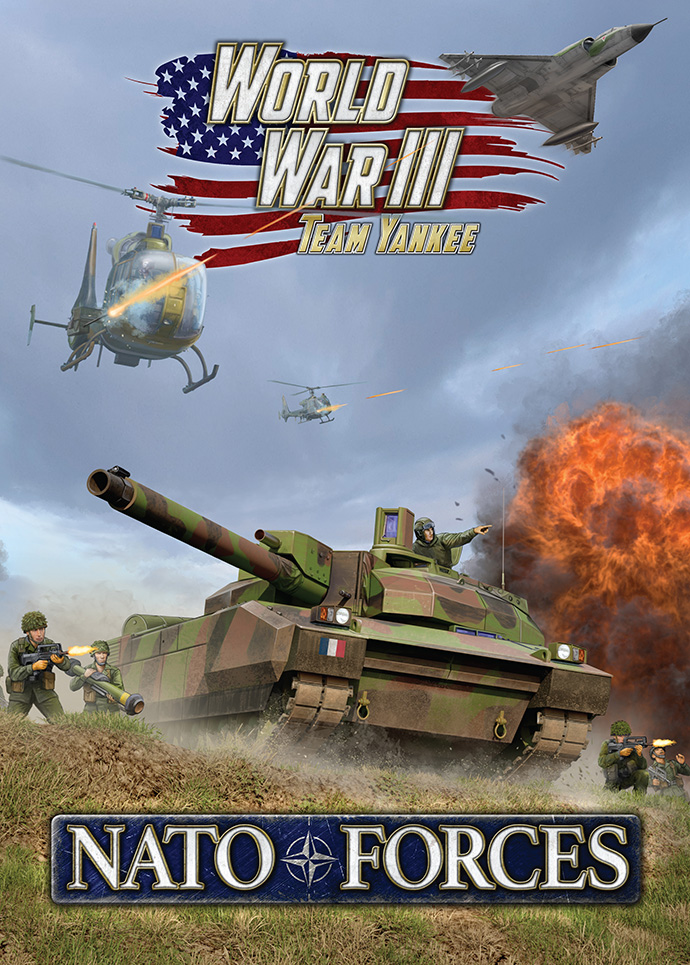 |
World War III: NATO Forces Design Notes
Canadian Forces
with Wayne Turner
Back in 2018, we released Free Nations as our first multi-national book for Team Yankee. It added four more nations to the roster of forces with which to play. Free Nations started as an idea to add some of the forces of the smaller NATO nations but grew into something a little more when it was suggested we add the French. The project transformed from a loose idea to do some downloadable content, into a fully-fledged book with four Western nations (well, technically five if you choose to run your ANZACs as New Zealanders).
We have now further expanded this book into World War III: NATO Forces by expanding the forces and units available to the original four choices, and have also added a fifth nation, the Belgians.
|
|
So, what do you get?
Inside you will find five different forces from four NATO nations (Canada, France, Netherlands, and Belgium) and the closely allied ANZACs (a combined Australian and New Zealand force). It also includes three Scenarios featuring the Canadians, French and Dutch.
|
|
 |
|
The Canadians were the first force we worked on and had been kicking about in various forms for a while, so they became an obvious candidate to include.
The Canadian section covers the background of the 4 Canadian Mechanized Brigade Group and the actions of Major Hanson’s Armoured Squadron. We also expand on the background first featured in Red Dawn with the Soviet invasion of North America to cover Canada’s home defence forces.
The new formations included in the expanded Canadian forces are the Leopard 2 Armoured Squadron. We thought this was a good choice for inclusion as it was a vehicle the Canadians eventually obtained and would make sense as an upgrade in times of war, especially for the Canadians fighting in Europe. The organisation of the Leopard 2 Armoured Squadron follows that of the Leopard 1 Armoured Squadron.
|
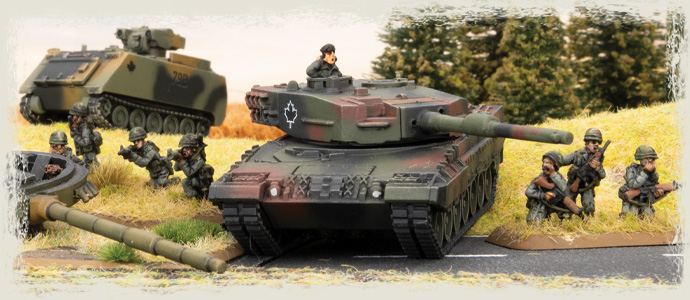 |
|
The Canadian forces in Germany continue to be based around 4 Canadian Mechanized Brigade Group. A Canadian Force can also field its Leopard C1 Armoured Squadrons and M113 Mechanized Companies, plus their Brigade Group Support. They can also call on either US or West German allied support units as well as another allied NATO formation. We have also added British Allied Support Units to represent the British training forces stationed in Canada.
To represent the Canadian forces in Canada we have added four new formations. These are the Cougar Armoured Squadron, Coyote Armoured Squadron, Grizzly Mechanised Company, and Airborne Company.
|
| |
|
The Canadians are a well-trained force with good motivation.
The Leopard 2 Armoured Squadron can field an HQ of 1 to 2 Leopard 2 tanks, and 2 to 4 Troops of 2 to 4 Leopard 2s. The Leopard 2 is armed with the 120mm L/44 tank gun with a Range 40”/100cm, ROF (Rate of Fire) 2/2, AT (Anti-tank) 22 and FP (Firepower) 2+. Its armour is much improved over the Leopard C1 (Front 18, Side 7, and Top 2). Its protection is further boosted by composite Chobham-style armour giving its Side a rating of 16 against HEAT weapons. The gun’s Advanced Stabiliser allows the tank to move up to 14”/35cm tactical.
Leopard C1 Armoured Squadron can field an HQ of 1 to 3 Leopard C1 tanks, and 2 to 4 Troops of 3 to 4 Leopard C1s. The Leopard C1 is the Canadian version of the West German Leopard 1A3 and is armed with the 105mm L7 tank gun with a Range 40”/100cm, ROF (Rate of Fire) 2/2, AT (Anti-tank) 19 and FP (Firepower) 2+. Its armour, though not heavy, is enough to protect it from most light weapons (Front 9, Side 5, and Top 1). Its protection is further boosted by Bazooka Skirts giving its Front and Side a rating of 10 against HEAT weapons. The gun’s Stabiliser allows the tank to move up to 14”/35cm tactical, though if it goes over 10”/25cm tactical it does gain a +1 penalty To Hit in shooting, but still has a Moving ROF 2, very handy in the right circumstances.
|
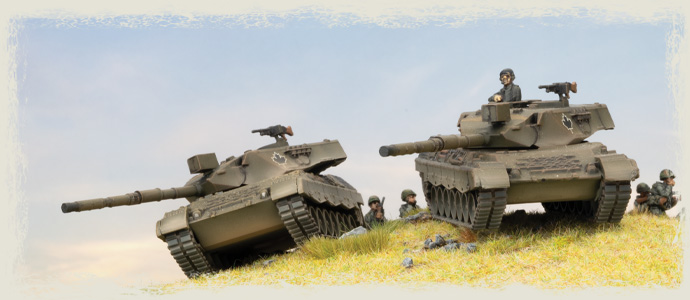 |
|
You can build the Leopard C1 from the new Leopard 1 plastic kit (as well as the Dutch, Australian, and West German variants). You can also take an M113 Mechanized Platoon, up to three Lynx Recce Patrols, and an M150 TOW anti-tank section as part of the Armoured Squadron formation.
Inside these formations, we have added additional options which include the ability to take Coyote Recce Patrols instead of Lynx Recce Patrols, and M113 TUA Anti-tank Sections instead of M150 TOW Anti-tank Sections.
The Lynx Recce Patrols field the M113 CRV Lynx, a lighter, shorter variant of the standard M113, used for reconnaissance missions. These unique-looking light vehicles are armed with .50 cal and 7.62mm machine-guns and are ideal for probing the enemy’s defences.
|
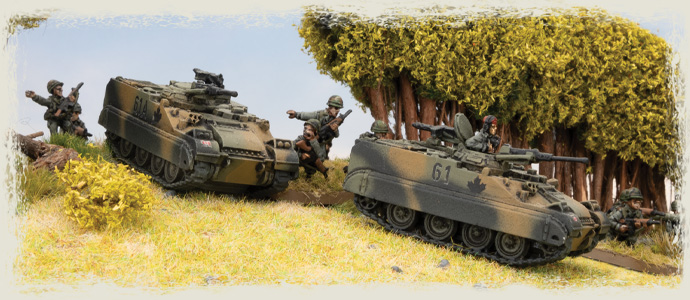 |
|
The Coyote Recce Patrols have the Coyote, which is a LAV-25 eight-wheeled armoured vehicle mounting a 25mm autocannon in a turret as used by the Americans.
The M150 TOW vehicle mounted a single TOW launcher on a M113 providing the large and cumbersome TOW with excellent mobility. This is an ideal weapon for setting ambushes against enemy armoured thrusts with its excellent Range 48”/120cm and AT 21. Its Guided and HEAT capabilities make it both accurate and lethal at long range.
The M113 TUA (TOW under armour) is the same vehicle as the Norwegian NM142 from World War III: Nordic Forces, a Norwegian conversion of the M113 that functions much the same as the US M901 TOW vehicle. This vehicle has the option to be armed with iTOW like the M150, or TOW-2 giving it Anti-tank 23.
|
| |
|
The M113 Mechanized Company is the second formation in the Canadians. It includes an HQ and two or three M113 Mechanized Platoons, a Leopard C1 Armoured Troop or Leopard 2 Armoured Troop, an M125 Mortar Platoon, up to three M150 TOW anti-tank sections or M113 TUA anti-tank sections, and up to three Lynx Recce Patrols or Coyote Recce Patrols.
The M113 Mechanized Platoon is based around three C2 SAW teams (ROF 2/2 with M72 LAW anti-tank) and three Carl Gustav teams (AT 17) with further firepower provided by a C5 GPMG team and a 60mm mortar. The .50 cal AA MGs or the Transport Attachment’s four M113 APCs provide additional firepower. The M113 mounted infantry have also been issued an upgrade. The Canadian mech infantry gain the option to take the French short-range anti-tank guided missile Eryx instead of the Carl Gustav. Though guided, it can still be used in Assault defensive fire, but like other guided weapons still cannot be used in the subsequent Assault combat. This weapon has a massive anti-tank of 24.
|
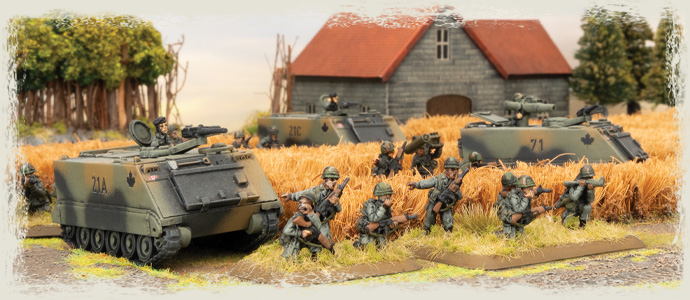 |
|
The M125 Mortar Platoon sees the Canadian C3 81mm mortars mounted in an armoured hull for mobility and protection. As part of the story’s background, we decided to have the Canadians purchase some M125 mortar carriers, as they just normally carry their mortars in a standard M113 and dismount them to fire.
The Cougar Armoured Squadrons were intended as training formations for the Leopards, as well as support firepower for the home service mech infantry. The Cougar is a 6-wheeled forerunner of the 8-wheeled Coyote/LAV-25, all having their origins in the Swiss Mowag Piranha. However, the Cougar is armed with a low-pressure 76mm gun like the British Scorpion light tank. With a much roomer fight compartment allowed for by its bigger hull, the crew are able to service the gun a little better giving it ROF 2/1 with Slow Firing on its moving ROF, but allowing the Cougar to maintain its Tactical speed of 10”/25cm. The gun has a range of 24”/60cm and Anti-tank 14. The Cougar is lightly armoured (Front 1, Side 1, Top 0). The Cougar Armoured Squadron is organised similarly to the Leopards above but can have a Grizzly Mechanised Platoon instead of an M113 mounted one. Its anti-tank option had the Iltis TOW Anti-tank Section instead of that of the M113 TUA.
|
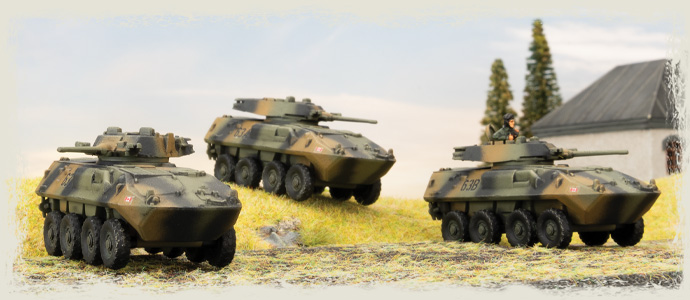 |
|
The Coyote Armoured Squadron is actually the same formation as above but with new freshly manufactured Coyotes replacing the Cougars. Like the Cougar, the Coyote was also intended in the dual rule of training vehicle and support vehicle. The Coyote has similar armour to the Cougar but with better Dash speeds and Cross. The M242 25mm gun may not have the same anti-armour punch as the 76mm, but it has a high rate of fire and the ability to fire as helicopters.
The Grizzly is the APC version of the Cougar and provides the transport for the Grizzly Mechanized Company. The formation includes an HQ and two or three Grizzly Mechanized Platoons, a Cougar Armoured Troop, an M125 Mortar Platoon, up to three M150 TOW anti-tank sections or Iltis TOW Anti-tank Sections, and up to three Lynx Recce Patrols or Coyote Recce Patrols.
The Grizzly Mechanized Platoon is based around five C2 SAW teams (ROF 2/2 with M72 LAW anti-tank) and one Carl Gustav team (AT 17) with further firepower provided by a C5 GPMG team and a 60mm mortar. The Carl Gustav can be replaced by the new Eryx guided missile. The Transport Attachment’s four Grizzly APCs provide additional firepower with their turret-mounted .50 cal machine-guns.
|
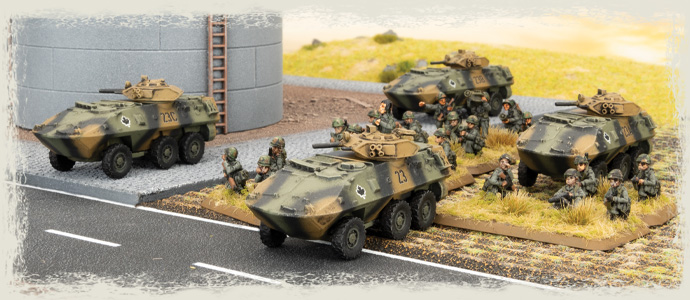 |
|
The final Canadian Formation is the Airborne Company based around the Canadian Airborne Regiment. A bit like the British SAS, the members of the Canadian Airborne Regiment come from the other regiments of the army. These troops can be carried into battle mounted in UH-1 Huey helicopters. The Formation contains two to three Airborne Platoons, a .50 cal HMG Platoons, a C3 81mm Mortar Platoon, up to three Iltis Recce Patrols, and up to three Iltis TOW anti-tank sections.
An Airborne Platoon is made up of six C2 SAW & C1 rifle teams with M72 anti-tank weapons, a Carl Gustav anti-tank team, and four UH-1 Huey helicopters. To this, they can add up to two C5 GPMG teams and an M19 60mm mortar. Like the other Canadian infantry, the Carl Gustav can be replaced with an Eryx anti-tank guided missile.
The C3 81mm Mortar Platoon gives you two to eight C3 81mm mortar teams that fire as artillery and provide smoke and indirect fire support to the company.
|
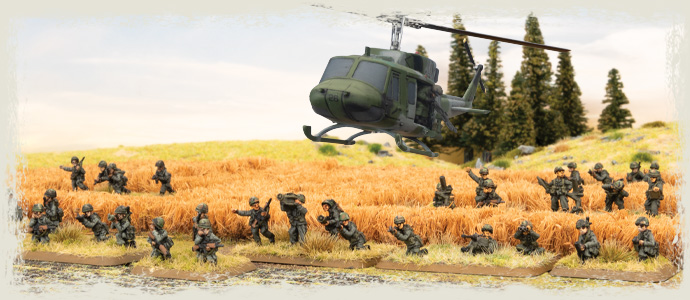 |
|
The .50 cal HMG Platoon provided four to eight tripod-mounted heavy machine-guns for fire support against infantry and light armour.
Like the Airborne Platoon, the C3 81mm Mortars and .50 cal HMGs can be carried in helicopters for airmobile missions.
The Iltis Jeep is a Volkswagen off-road light utility vehicle manufactured in Canada and used in the same role as the American Jeep or mute. In the Iltis TOW Anti-tank Section, the Iltis mounts an improved TOW anti-tank guided missile, providing anti-tank support to the airborne troops on a light mobile platform.
The Iltis is also used in the reconnaissance role in the Iltis Recce Platoon, scouting ahead and probing for the enemy.
|
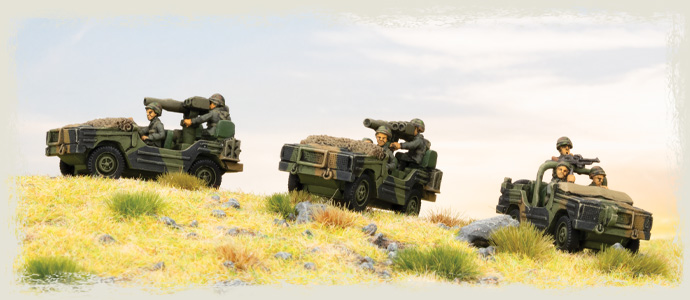 |
|
Support
The Canadian Support includes M109 self-propelled howitzers, an M113 OP observation vehicle, an ADATS Air Defence Platoon, and a M113 Blowpipe Air Defence Section.
The Canadians used the short howitzer M109, providing it with powerful artillery capabilities. It can reach out to 88”/220cm with its bombardments, with AT 4 versus Top Armour and FP 2+.
The ADATS mounts the Oerlikon-Contraves’s Air Defence Anti-tank System (hence ADATS) on a modified M113 hull. These were under development in the 1980s, and as it is such a cool bit of kit, we thought we’d include it in Team Yankee. It can be fired at air or ground targets. At aircraft, it has a range of 72”/180cm, ROF 3, and FP 3+ and uses the Guided AA rule. As an anti-tank weapon, it has a range 16”/40cm – 64”/160cm, ROF 1, AT 24, FP 3+ and uses the Guided and HEAT rules.
|
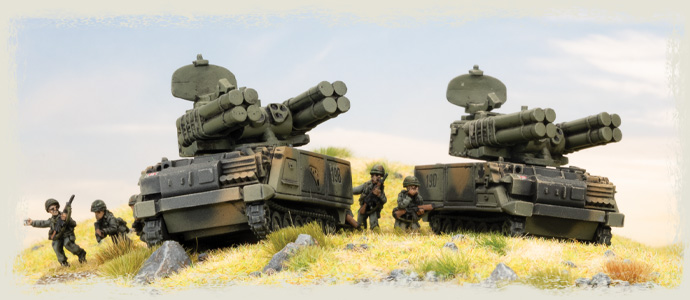 |
|
Like the British, the Canadians used the Blowpipe man-portable air-defence system. They are transported in M113 APCs and can be used to shoot at a tank in an emergency, as well as aircraft.
Because the 4 Canadian Mechanized Brigade Group was earmarked as a mobile reserve formation, they could fight alongside either the US 7th Corps or the West German 2. Korps, so you can choose to take support units from either of these, but not both. In Canada, they could also call on British troops from the British Army Training Unit Suffield who were stationed in Alberta.
Of course, any NATO Formation can be taken as an Allied Formation.
|
| |
|
Bonus Content
At the back of World War III: NATO Forces you will also find two pages on NATO Missile Upgrades. This section allows you to field West German, British, and American forces with the newer versions of anti-tank guided missiles (this will also be available as a PDF download).
West Germans can take Milan 2 and HOT 2, the British can take Milan 2, and the Americans can take M47 Dragon 2 missiles.
The Milan 2 increases the missile’s anti-tank to 24.
The HOT 2 increases the missile’s anti-tank to 24
The M47 Dragon 2 increases the missile’s anti-tank to 21.
Like many of these upgrades, where a Unit has a choice, all Units in the Force must take the same type.
|
|
Scenarios
As well as the five forces, World War III: NATO Forces also includes three scenarios featuring Canadian, Dutch and French forces. These can be played with the suggested forces, or you can use the suggested points to field alternative forces in the scenarios. The scenarios can be run as a linked campaign, or as individual one-off games.
|
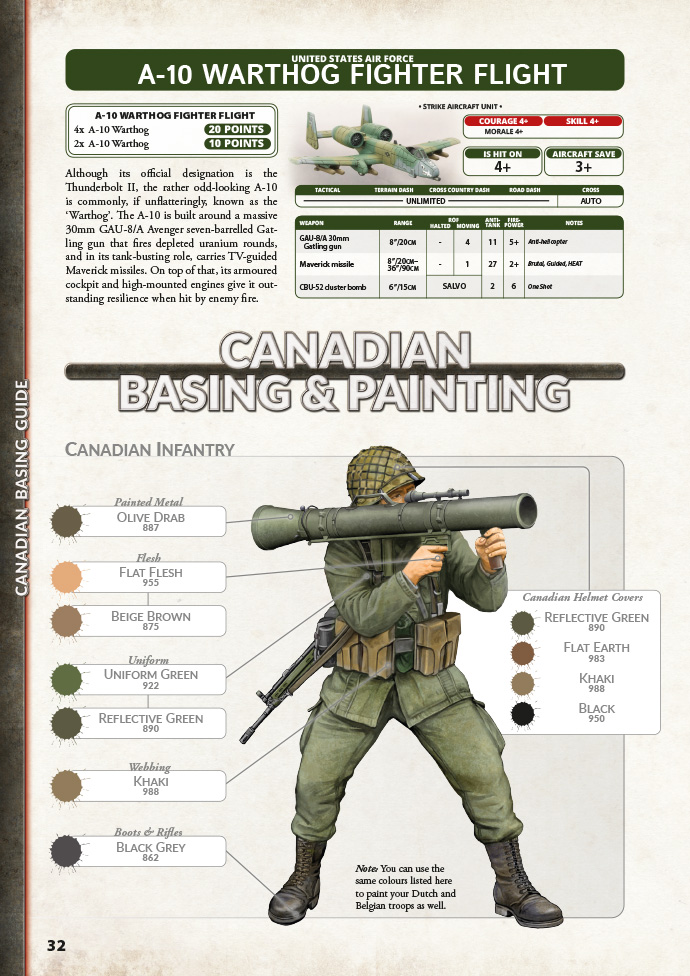 |
Painting and Models
The final sections in each nation’s part of World War III: NATO Forces include painting and basing guides. This includes armour painting for Yellow Olive and NATO 3-colour, infantry painting guides for Australians, French, Canadians, Dutch, and Belgians, and aircraft colour guides. Basing guides for the teams of World War III: NATO Forces infantry forces.
After each nation section, there is a comprehensive guide to the models of World War III: NATO Forces, listing all the great new boxes and packs that will be coming out for the Canadians, French, Dutch, ANZACs, and Belgians.
It’s a great new book with plenty of forces to choose from, whether you a looking for a new NATO force to field or looking at adding a new formation to a current NATO force.
~Wayne
|
|
|
|